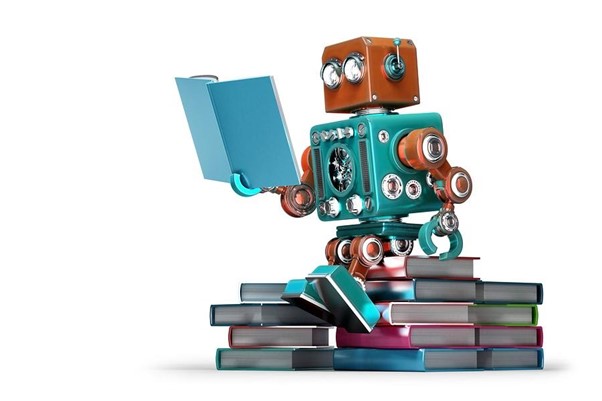Will AI Tools Replace Human Writers in the Future?
Automation and artificial intelligence (AI) are transforming businesses; but will they replace human writers?

The process of automation of labor has been going on intensively for a couple of centuries now. At first, machines used to do repetitive, tedious, physical work that humans couldn’t do as effectively.
However, thanks to AI technology, we’ve started automating another kind of work as well. The kind of work that seemingly demands human creativity and intelligence, like design, programming, or writing.
In this article, we’ll be looking into the possibilities and potential limits of AI writing. You may get suspicious at first, given that in recent years we’ve witnessed numerous serious flaws in automatic content generators and translators. Nevertheless, there’s a school of thought among experts that claims they can be at least as good as humans. Joe Pulizzi, the founder of the Content Marketing Institute, even goes so far as to claim this:
“In 10 years the majority of content will be generated by software. In 20 years, humans will wonder why we wasted so much time on content creation. I can’t see any other way around this.”
Now, in order to decide whether Pulizzi’s view makes sense, we researched and tested some of the tools commonly used today. We’ll try to present the findings by answering 12 crucial questions about AI writers.
1. What exactly do AI writing tools do?
First of all, AI writing tools are not just about generating instant content, but these tools can also help writers and marketers with virtually all parts of the writing process. Here are some of the things AI can do, more or less successfully:
Long-form content creation, either based on a set of keywords or on the manually written introductory paragraph(s)
Creation of all sorts of short content – ad copy, product descriptions, website microcopy, social media posts, and even slogans
Summarizing long-form content and compressing it into shorter forms
Rewriting and rephrasing of existing content
Conducting in-depth research that precedes writing
Content improvement and optimization (including SEO)
Suggesting how to continue a sentence or a paragraph and auto-completing them based on what’s previously written
Generating titles and subtitles
Creating listicles and article ideas
2. How do they do it?
Most modern AI writing tools are built on incredible amounts of data and the concept of deep learning. AI tends to learn by itself the majority of the stuff it “knows”. Human scientists and engineers basically just set some initial parameters, feed the system with data, and let it develop its own algorithms, too complicated for a human programmer to write or even conceive.
“The data” here is simply hundreds of billions of words and a colossal amount of different types of content, used to train or “teach” the algorithm how natural language works. And the most advanced language model we have at this moment is GPT-3, developed by OpenAI.
Microsoft has bought exclusive licensing for GPT-3, but OpenAI still offers an API such that other users have access to the model’s output, but not to the source code itself. This means that GPT-3 technology is built into many of the AI writing tools on the market today.
There are claims that GPT-3 is extremely successful and even “eerily excellent”. And research showed that as many as 48% of people, presented with 200-word articles written by a human and AI respectively, couldn’t guess which is which. Admittedly, research was done on a small sample of just 80 people, but these results are still impressive.
Finally, we’ve seen a number of test articles written by AI published in mainstream media. This one, published by Guardian, was entirely written by software but was also edited and rearranged by Guardian’s editors. On the one hand, it’s quite remarkable to think that AI can display such coherence in speech and accuracy in the use of language. But even with all the editing, GPT-3 is far from perfect, and we’ll see just why in a minute.
3. Can AI write coherently?
The short answer would be: yes, they do. Kind of. When it needs to deliver a sentence or a paragraph or a short article, AI can generate pretty accurate and convincing content. All you need to do is write a few introductory sentences or type in certain keywords and decide on a topic.
For instance, this is what we tried with one of the tools, Zyro. It automatically generates a short description of your business (basically, a short “about us” page), based on what type of business you’re running. We’ve tested it for “Mexican restaurants” and here’s what we got in a second or two:
“We take a diverse approach to our menu and have expanded our menu to include a wide range of dishes, with a special focus on local flavours. We are passionate about sharing, and we want to encourage local communities to share our love and passion for food with their friends and neighbours. We are passionate about making good food, with a focus on using local and seasonal produce when possible.”
That paragraph may be a bit generic, but it’s quite coherent. However, once we get to longer forms, it gets tricky. Coherence in terms of order of words in a sentence or a consistent trail of “thought” is more-less solid on short samples, but the issue happens when a system needs to make more complex conclusions and maintain the overall structural and logical coherence of a longer piece of content.
4. Can AI really think and feel?
There’s a lot of confusion among critics when it comes to assessing the capabilities of AI. And when they claim that AI can never replace human writers, they often refer to the lack of “soul”, “genuine emotions”, “true creativity”, or “real intelligence” in AI software and their writing.
But this is a mistake as nobody expects machines to have souls and this is not at all a valid argument against AI. We shouldn’t dismiss it only on that basis, as a machine can have a soul without us knowing it, or it can cheat us into believing it has a soul like it was seen long ago in the Chinese room thought experiment.
It’s not about whether AI systems have “true” creativity and intelligence, it’s about whether they can look like they have them, based on the content they produce.
5. Is AI-written content readable?
Yes, it is. This is not too problematic, as the text remains mostly intelligible. Even when AI happens to make some basic mistakes, it’s mostly easy to read. Let’s take a look at this example. We tried to use AI writer to generate a long-form article about the best places to visit in Spain. The software generated multiple versions of this article, and here’s how one of the versions starts:
“I have compiled a list of the best cities in Spain to visit. Or, if you only have 10 days in Spain, there are plenty of places to explore. Whether you decide to visit the big and lively Spanish cities or the small towns with a rich history in Spain, there is something for everyone. As mentioned above, large and beautiful Barcelona and Madrid may be in the spotlight, but smaller cities in Spain such as Toledo are also worth a visit.”
Not too elegant, but when it comes to being readable and easy to understand, the paragraph definitely passes the test.
6. Is it comprehensible?
Depends. Most of the time it is, especially with more powerful and better-equipped software. But it can get easily confused if your input gets too particular. For instance, with Zyro, we checked another mode they offer (“Go Wild”) – you start the piece with 2-3 sentences of your own and then let the software finish it for you.
In these two sentences, we tried to tell very specific things about a restaurant (not a Mexican one this time), like that it’s vegan, green, and respects a bunch of specific values, and then see what happens.
What happened was weird and genuinely amusing. The next sentence that the software wrote after our paragraph was fully in caps lock, mentioning an egg sandwich in a strange context, and after that, it started rambling on about how eggless sandwiches are trending on Twitter and Pinterest. In the end, AI questioned whether people would “feel inspired to make something for someone else just based upon where their eggs come from”. Needless to say, I’ve never mentioned any eggs. So let’s leave this at “depends”.
Discover How SpotlerCRM Can Help
7. Is it on-topic?
Most of the time. Once AI recognizes the main topic correctly (meaning there’s no equivocation or confusion in this process), it mostly stays focused on it.
On the other hand, the way that the topic is analyzed and the lines of reasoning that stretch throughout long-form articles are very problematic. But that seems to be a different problem, which comes from the very methodology that most language models in the industry (including GPT-3) use at this time, and we will explain this soon.
8. Is it well-structured?
Mostly no. From what we’ve seen first-hand with various tools, this remains one of the most obvious problems. After 200 or 300 words, the structure usually just falls apart. AI often circles around, going back to the same topics several times, and sometimes it just introduces a seemingly random idea that’s not completely off-topic but has no connection to anything previously mentioned in the article.
Also, there’s no gradation, there’s no logical trail of thought that can keep the structure solid, and the dynamics of the article are either nonexistent or weird and completely alien. Often it’s just a bunch of random loosely related ideas presented in no specific order that create no feeling of a coherent, meaningful whole.
9. Does AI seem like it actually thinks?
The ultimate verdict has to be – no. It doesn’t. At times it seems like it does, but when you spend enough time reading AI-generated content, you easily start telling it apart from human writing.
And this apparently comes to the very methodology that’s in the heart of GPT-3 and most AI writers. They don’t really know things, in any sense. To put things simply, AI doesn’t get to know the language by getting to know the things in the real world and words that denote particular things. It just uses its processing power to analyze billions of words and how they stand in relation to each other.
In essence, AI just reorganizes words it has already seen to make sentences similar to those it has already seen, but does it with no reference to the things in the real world or even to general concepts that lie beneath the words.
And this is what causes massive confusion and results in numerous mistakes and AI’s general inability to seem like it understands what it writes about. The authors of a Technology Review article on this topic used a brilliant analogy to explain what the problem is with GPT-3:
“GPT is odd because it doesn’t ‘care’ about getting the right answer to a question you put to it. It’s more like an improv actor who is totally dedicated to their craft, never breaks character, and has never left home but only read about the world in books. Like such an actor, when it doesn’t know something, it will just fake it. You wouldn’t trust an improv actor playing a doctor to give you medical advice.”
10. Is AI-produced content relatable?
Well, since we’re creatures that think and AI is not (nor it seems like that), the answer is clearly no. But not only because AI can’t show emotions, but on the contrary, because it can’t convince us it’s sentient.
To be fair, some 100-200 word pieces can seem like they were written by a human. A very tired human who doesn’t really care a lot about this content. But still a human. However, sometimes it’s just nonsense that a human writer with a basic understanding of language would never write.
Also, content is, unsurprisingly, very generic and way too general most of the time. What people relate to are specific stories, experiences, and independent original ideas and conclusions, and AI offers none of these.
11. How can AI writers help us then?
Everything we’ve said so far seems like we’re taking a stance against the use of AI in writing. However, there’s a huge difference between letting AI write for you and using AI to help you write.
The latter can be very useful and should definitely be embraced. The fact that AI still can’t do independent writing work without human involvement and editing doesn’t mean it can’t be helpful.
A number of these tools are very good in suggesting topics or subtitles, scraping raw data and transforming it into sensible information, or even auto-completing sentences and paragraphs. You just need a human writer to distinguish between utter nonsense and a good idea that might have not occurred to them otherwise. Some more advanced AI writing tools like Writesonic, Jasper, or Article Forge can be very helpful in this respect.
Also, as we’ve already seen, AI can be useful for short, simple forms but it still needs to be overlooked by a person. Just like with design, programming, and other creative fields, humans and AI complement each other very well, with AI basically handling the boring part of the job.
That kind of illustrates the point of automation of all labor, not just creative work. It should free people from tiresome, tedious, monotonous tasks that are a part of their job. Creative work and creative tasks shouldn’t be on this list, and it seems that AI will be able to help writers and marketers focus on the fun and fulfilling aspects of their work in the future.
12. And finally – will AI tools replace human writers in the future?
For now, there’s no reason to think that. As we’ve seen, most of what they’ll become in the near future is our worthy assistants. To be honest, a writer writing about being irreplaceable at his job may seem a bit biased, but if a robot comes into my office one day and starts writing, I’ll have to reconsider everything said above and buy the robot a cup of coffee. And then write an article about robots’ limited coffee-drinking capabilities.
Jokes aside, it seems that in order to achieve truly revolutionary results, our natural language processing methods will have to change their main course.
And if that happens, it’s really hard to tell how far AI can go, in writing and in any other field. Noam Chomsky argues that we are born wired for language – it’s just the way we evolved as a species. So it may be that the algorithms that our genes and brains have developed for millennia can’t be easily replicated or replaced with algorithms created by machines. Or can they? The future will tell.
Really Simple Systems is now Spotler CRM
The same great technology, a CRM platform that is focused on the needs of B2B marketers, provided by the same great team, at a great price!



